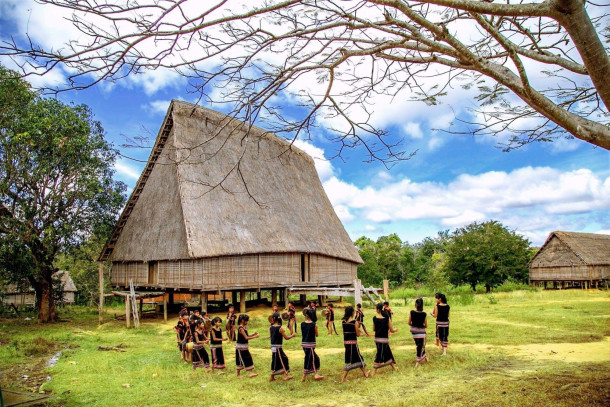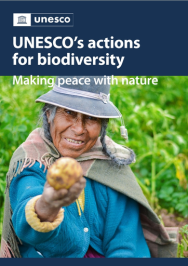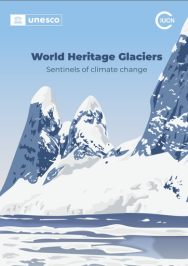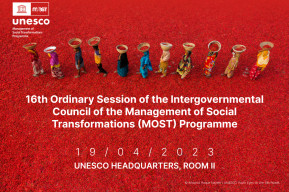News
COP 15 renews the Joint Programme on Nature/Culture linkages

Read the full decision adopted by COP 15
The programme seeks to recognize and promote natural and cultural heritage and diversity as a pathway to the global biodiversity framework’s vision of living in harmony with nature by 2050.
Message by Mr Xing Qu, UNESCO Deputy Director-General
Message in French and English on the linkages between Culture and Nature

The Kaya forests of coastal Kenya
The Kaya forests of coastal Kenya are sacred to local populations. When the Mijikenda make use of its natural resources, they integrate the importance of preserving these because their rituals, traditions and practices are intertwined with the existence of the forest. This symbiotic relationship, as well as its underpinning knowledge, is in danger. Pressure on land resources, urbanization and social transformations are driving away the forest’s prime custodians, posing an existential threat to the area’s natural and social fabric. The “Traditions and practices associated with the Kayas in the sacred forests of the Mijikenda” were inscribed in 2009 on the List of Intangible Cultural Heritage in Need of Urgent Safeguarding.
The Jungfrau-Aletsch World Heritage natural site
A World Heritage natural site, the Jungfrau-Aletsch area is the most glaciated part of the Swiss Alps. It contains Europe’s largest glacier and a range of classic glacial features that have been immortalised in European artistic expressions. It is also home to a unique way of life that is strongly connected to the mountains and their biodiversity. Since 1980, 20–30% of the ice has melted. If this trend continues, by 2050, 75% of the glaciers in the Swiss Alps will have disappeared. This transformation not only has local repercussions for the inhabitants’ traditional lifestyle and the economy (particularly tourism). Glacier melt in the Alps will also affect important European rivers such as the Rhine, the Rhone or the Danube and, thus, pose a threat to Europe’s freshwater supply.
The Mura-Drava-Danube Transboundary Biosphere Reserve
The Mura-Drava-Danube Transboundary Biosphere Reserve is the first to span five countries: Austria, Croatia, Hungary, Serbia and Slovenia. This reflects the will of its inhabitants to cooperate in the interests of the conservation of biodiversity and its sustainable use. Europe’s largest dynamic river ecosystem has historically been subject to different and even conflicting management and land use practices (particularly for a good part of the 20th century when some of these countries were separated by the Iron Curtain). The 12-year period separating the a joint declaration of intent between the five environment ministers the designation was a breakthrough in itself; now, the objective is to create a model for river basin management based on international cooperation, while building bridges between people and nature.
The Arganeraie Biosphere Reserve in southwest Morocco
The Arganeraie Biosphere Reserve in southwest Morocco was designated by UNESCO in 1998. Today, the forest covers 800 km2 and the Argan tree (Argania spinosa) is the defining species of the eco-region on which over 1,200 other plant and animal species depend – including several that are endemic. The forest acts as a natural barrier against the advancement of the desert, preventing erosion and protecting water resources. For centuries, the oil of the Argan tree has been a mainstay of the Amazigh (Berber) people of the region. Since its designation by UNESCO, this oil has found a growing customer base in European and other high-value markets. Most of the seeds are harvested by the women’s Argan oil cooperatives, which ensure that the oil sold on national and international markets meets the required quality standards. These cooperatives also help the local population benefit from related opportunities. In places where cooperatives act for the benefit of the population, communities have attained a higher level of socio-economic development and female empowerment.
The Tsá Tué Biosphere Reserve in Canada's Northwest territories
Located in Canada’s Northwest Territories, the Tsá Tué Biosphere Reserve encompasses the last large pristine arctic lake. Boreal forest and taiga cover much of the watershed and form the habitat of wildlife that includes muskox, moose and caribou. The human residents of the site are the Sahtuto’ine, the ‘Bear Lake People’, the First Nation Dene community, who have always relied on their spiritual and cultural connection to the land and lake. The community established a Stewardship Committee in 2013 and led a designation process for Tsá Tué to become part of the World Network of Biosphere Reserves. The designation was celebrated in 2016 and, a few months later, the Canadian government granted Deline the right to self-government. Tsá Tué is the first biosphere reserve in the world to be designed and managed by a First Nation.
Five biosphere reserves in the north of Italy: the Po Delta, Appennino Tosco-Emiliano, the Ledro Alps and Judicaria, Sila and the Tuscan Islands
The north of Italy is home to five biosphere reserves: the Po Delta, Appennino Tosco-Emiliano, the Ledro Alps and Judicaria, Sila and the Tuscan Islands. Between them, they embody a wide variety of habitats ranging from the wetlands of the Po Delta to the slopes and meadows of the Alps. The preservation of this landscape is paramount not only for local biodiversity, but also for gastronomic specialties that rely on locally grown ingredients. Both the ingredients, which include Parmigiano Reggiano, Parma Ham and unique kinds of risotto, and the traditions involved in their preparation have brought communities together around the dinner table for centuries. In order to celebrate this unique ecological, social and cultural heritage, these five biosphere reserves have created UPVIVIUM. This initiative awards producers, restaurant owners and food producers who keep traditional and sustainable practices alive, while offering some of the gastronomic delights for which Italy is renowned. UPVIVIUM also promotes products that are guaranteed ‘Zero Km’ (food produced, sold and eaten locally) and safeguards both bred and cultivated biodiversity.











